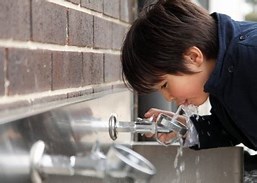You may have read or heard that Hamilton Heights School Corporation was among six Central Indiana counties flagged for elevated lead levels in the water. What exactly does that mean for your student? Is the water at Heights safe to drink? In one word, yes.
Here’s the backstory:
The Indiana Finance Authority (IFA) offered a program (Lead Sampling Program for Public Schools) to test water that flows through a variety of plumbing components in Heights school buildings including old solder, brass parts, water fountain cooling tanks, and galvanized pipes. Because isolating the exact source of lead can be challenging, Hamilton Heights, along with schools across the state, took advantage of the opportunity to participate in this program. Samples were collected in the spring of 2018.
The preliminary report of the test results, to date, found that 56 (and counting) schools across six Central Indiana counties had elevated lead levels in the water. Schools in Boone, Hamilton, Hendricks, Johnson, Marion, and Shelby counties tested positive for lead levels above the EPA recommendation of 15 parts per billion (ppb).

Participating in a lead sampling program offered by the state, Hamilton Heights was among the school districts throughout Indiana who took advantage of the opportunity to check their water systems for lead and take corrective action to ensure safe and quality drinking water for students and staff. (Photo provided)
According to information provided by the IFA, “based on a preliminary review of the sample results, while the majority of schools in our program (61 percent) had at least one fixture over the EPA Action Level (15 ppb), only a few fixtures within each building (8 percent on average) tested above this remediation threshold. These trends are consistent with other statewide school lead sampling programs. Many schools reported that drinking water fixtures with elevated lead concentrations were either infrequently used or purchased prior to 1990.
At Heights, at least one fixture in each building was identified, of which many were not primary sources of drinking water. Upon receipt of the report, Heights began remediation and corrected nearly all. Fixtures identified were replaced and/or identified as “handwashing only.”
The last of the areas where remediation efforts are taking place are at the high school and involve outdoor fountains that are rarely, if ever used. This is expected to be complete by the end of next week. Areas will be retested and sampled periodically to enable the corporation to be in a better position to proactively manage and maintain a high-quality water system.
Is the drinking water safe? Yes. Heights plans to keep it that way.
